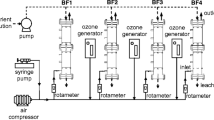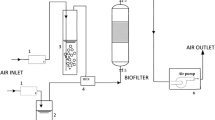Abstract
Petroleum oil refineries are massive emitters of risky volatile organic compounds (VOCs). Among the VOCs, toluene is taken into account as a significant pollutant. In the present study, a compost biofilter is used to treat the toluene vapor. However, an elimination capacity and removal efficiency of the biofilter was investigated for a wide range of toluene concentrations (0.29–3.8 g m−3) and operated for 54 days effectively. Elimination capacity of 93 g m−3 h−1 was recorded as maximum value at a toluene inlet concentration of 114 g m−3 h−1. An elimination capacity was perpetually better at the lower section of the biofilter, and therefore, the value was around 40–60 g m−3 h−1. The high removal efficiency of 97% was obtained at inlet toluene load of 60.55 g m−3 h−1. Hence, the biofilm was quite sensitive to handling transient loading conditions. The pressure drop had no vital impact on the biofilter performance. An Ottengraf model was applied to all phase of biofilter operation in each of the diffusion limiting region and reaction limiting region. The parameters of the model K 1 (75.95 g1/2 m−3/2 h−1) and K 0 (90.51 g m−3 h−1) were obtained from diffusion and reaction limiting region severally. However, K 1 was used to calculate the theoretical elimination capacities, and therefore, K 0 was used to discover the biofilm thickness. By the way, the average biofilm thickness was found to be 0.98 mm from reaction limiting region.










Similar content being viewed by others
Abbreviations
- EBRT:
-
Empty bed residence time, sec
- EC:
-
Elimination capacity, g m−3 h−1
- IL:
-
Inlet loading rate, g m−3 h−1
- RE:
-
Removal efficiency, %
- K 1 :
-
Parameter of the model, g1/2 m−3/2 h−1
- V :
-
Bed volume, m3
- Q :
-
Volumetric gas flow rate, m3 h−1
- C gi :
-
Toluene concentration at the inlet, g m−3
- C go :
-
Toluene concentration at the outlet, g m−3
- k 0 :
-
Zero-order kinetic constant, g m−3 h−1
- D :
-
Toluene diffusion coefficient in the biofilm, m2 s−1
- A s :
-
Specific surface area of the bed, m−1
- K H :
-
Henry’s coefficient for toluene in water, dimensionless
- K 0 :
-
Parameter of the model g m−3 h−1
- δ :
-
Thickness of the biolayer, m
References
Malakar S, Saha PD (2015) Estimation of VOC emission in petroleum refinery ETP and comparative analysis with measured VOC emission rate. Int J Eng Sci 4:20–29
Wei W, Wang S, Hao J, Cheng S (2014) Trends of chemical speciation profiles of anthropogenic volatile organic compounds emissions in China 2005–2020. Front Environ Sci Eng 8:27–41
Mathur AK, Majumder CB (2008) Biofiltration of benzene emissions: biofilter response to variations in the pollutants inlet concentration and gas flow rate. J Sci Ind Res 67:243–248
Edokpolo B, Yu QJ, Connell D (2014) Health risk assessment of ambient air concentrations of benzene, toluene and xylene (BTX) in service station environments. Int J Environ Res Public Health 11:6354–6374
Rene ER, Murthy D, Swaminathan T (2005) Performance evaluation of a compost biofilter treating toluene vapors. Process Biochem 40:2771–2779
WHO (2000) Air quality guidelines for Europe, European series, no. 91, 2nd edn. WHO Regional Publication, Copenhagen, pp 1–288
Gallastegui G, Ramirez A, Elias A, Jones JP, Heitz M (2011) Performance and macrokinetic analysis of biofiltration of toluene and p-xylene mixtures in a conventional biofilter packed with inert material. Biores Technol 102:7657–7665
Alagappan G, Cowan R (2003) Substrate inhibition kinetics for toluene and benzene degrading pure cultures and a method for collection of respirometric data for strongly inhibited cultures. Biotechnol Bioeng 83:798–809
Du Plessis CA, Strauss JM, Riedel KHJ (2001) BTEX catabolism interactions in a toluene acclimatized biofilter. Appl Microbiol Biotechnol 55:122–128
El-Naas MH, Acio JA, El Telib AE (2014) Aerobic biodegradation of BTEX: progresses and prospects. J Environ Chem Eng 2:1104–1122
Rahul Mathur AK, Balomajumder C (2013) Biological treatment and modeling aspect of BTEX abatement process in a biofilter. Biores Technol 142:9–17
Jihyeon S, Seungkyu S, Supjang H, Sun-Jin H (2012) Kinetics and simulations of substrate interactions during the biodegradation of benzene, toluene, p-xylene and styrene. J Environ Sci Health Part A 47:1027–1035
Kennes C, Montes M, Lopez ME, Veiga MC (2009) Waste gas treatment in bioreactors: environmental engineering aspects. Can J Civ Eng 36:1887–1894
Perry RH, Green DW (2008) Perry’s chemical engineers’ handbook, 7th edn. McGraw-Hill Companies Inc, pp 456–457
Govind R (2009) Biofiltration: an innovative technology for the future. http://www.prdtechinc.com/PDF/PRDBIOFILTERR%26DMAGAZINEPAPER.pdf. Accessed 24 July 2009 (15:43)
Rahul Mathur AK, Balomajumder CB (2013) Performance evaluation and model analysis of BTEX contaminated air in corn-cob biofilter system. Biores Technol 133:166–174
Padhi SK, Gokhale S (2014) Biological oxidation of gaseous VOCs—rotating biological contactor a promising and eco-friendly techniques. J Environ Chem Eng 2:2085–2102
Mohamad AF, Amirreza T, Mohanadoss P, Abd Majid MZ, Tony H, Amin G (2013) Biofiltration process as an ideal approach to remove pollutants from polluted air. Desalin Water Treat 52:19–21
Elmrini H, Bredin N, Shareefdeen Z, Heitz M (2004) Biofiltration of xylene emissions: bioreactor response to variations in the pollutant inlet concentration and gas flow rate. Chem Eng J 100:149–158
Sakunthala M, Sridevi V, Chandana lakshmi MVV, Vijay kumar K (2013) A review: the description of three different biological filtration processes and economic evaluation. J Environ Sci Comput Sci Eng Technol 2:91–99
Arulneyam D, Swaminathan T (2004) Biodegradation of mixture of VOCs in a biofilter. J Environ Sci 16:30–33
Zare H, Najafpour G, Rahimnejad M, Tardast A, Gilani S (2012) Biofiltration of ethyl acetate by Pseudomonas putida immobilized on walnut shell. Biores Technol 123:419–423
Anet B, Couriol C, Lendormi T, Amrane A, Le Cloirec P, Cogny G, Fillières R (2013) Characterization and selection of packing materials for biofiltration of rendering odorous emissions. Water Air Soil Pollut 224:1–13
Dorado AD, Lafuente FJ, Gabriel D, Gamisans X (2010) A comparative study based on physical characteristics of suitable packing materials in biofiltration. Environ Technol 31:193–204
Lebrero R, Estrada JM, Munoz R, Quijano G (2014) Deterioration of organic packing materials commonly used in air biofiltration: effect of VOC-packing interactions. J Environ Manag 137:93–100
Zilli M, Borghi MD, Converti A (2002) Toluene vapors removal in a laboratory-scale biofilter. Appl Microbiol Biotechnol 54:248–254
Xi J, Hu HY, Qian Y (2006) Effect of operating conditions on long-term performance of a biofilter treating gaseous toluene: biomass accumulation and stable-run time estimation. Biochem Eng J 31:165–172
Cho E, Galera MM, Lorenzana A, Chung WJ (2009) Ethylbenzene, o-Xylene, and BTEX removal by Sphingomonas sp. D3K1 in rock wool compost biofilters. Environ Eng Sci 26:45–52
Aly Hassan A, Sorial G (2009) Biological treatment of benzene in a controlled trickle bed air biofilter. Chemosphere 75:1315–1321
Singh RS, Rai BN, Upadhyay SN (2010) Removal of toluene vapors from air stream using a biofilter packed with polyurethane foam. Process Saf Environ Prot 88:366–371
Zhu Y, Li S, Luo Y, Ma H, Wang Y (2016) A biofilter for treating toluene vapors: performance evaluation and microbial counts behavior. PeerJ 4:2045
Singh K, Singh RS, Rai BN, Upadhyay SN (2010) Biofiltration of toluene using wood charcoal as the biofilter media. Biores Technol 101:3947–3951
Zamir SM, Halladj R, Nasernejad B (2011) Removal of toluene vapors using a fungal biofilter under intermittent loading. Process Saf Environ Prot 89:8–14
Rene ER, Murthy DVS, Swaminathan T (2010) Steady and transient-state effects during the biological oxidation of gas-phase benzene in a continuously operated biofilter. Clean Technol Environ Policy 12:525–535
Cheng Z, Lu L, Kennes C, Yu J, Chen J (2016) Treatment of gaseous toluene in three biofilters inoculated with fungi/bacteria: microbial analysis, performance and starvation response. J Hazard Mater 303:83–93
Zarook SM, Shaikh AA, Ansar Z (1997) Development, experimental validation and dynamic analysis of a general transient biofilter model. Chem Eng Sci 52:759–773
Ottengraf SPP, Van Den Oever AHC (1983) Kinetics of organic compound removal from waste gases with a biological filter. Biotechnol Bioeng 25:3089–3102
Saravanan V, Rajamohan N (2009) Treatment of xylene polluted air using press mud based biofilter. J Hazard Mater 162:981–988
Sene L, Converti A, Felipe MGA (2002) Sugarcane bagasse as alternative packing material for biofiltration of benzene polluted gaseous streams: a preliminary study. Biores Technol 83:153–157
Ortiz I, Revah S, Auria S (2002) effects of packing material on the biofiltration of benzene, toluene and xylene vapors. Environ Technol 24:265–275
Rajamanickam R, Kaliyamoorthi K, Ramachandran N, Baskaran D, Krishnan J (2016) Batch biodegradation of toluene by mixed microbial consortia and its kinetics. Int Biodeterior Biodegrad 119:282–288
Cox HHJ, Deshusses MA (2002) Co-treatment of H2S and toluene in a biotrickling filter. Chem Eng Sci 87:101–110
Fitch MW, Ellen E, Zhang B (2002) 1-Butanol removal from a contaminated airstream under continuous and diurnal loading conditions. J Air Waste Manag Assoc 52:1288–1297
Devinny JS, Deshusses MA, Webster TS (1999) Biofiltration for air pollution control. Lewis Publisher, Boca Raton, p 318
Delhomenie MC, Bibeau L, Heitz M (2002) A study of the impact of particle size and adsorption phenomena in a compost-based biological filter. Chem Eng Sci 57:4999–5010
Sun YM, Quan X, Chen JW, Yang FL, Xue DM, Liu YH, Yang ZH (2002) Toluene vapors degradation and microbial community in biofilter at various moisture content. Process Biochem 38:109–113
Eldon RR, Balsam TM, Maria CV, Kennes C (2012) Biodegradation of BTEX in a fungal biofilter: influence of operational parameters, effect of shock-loads and substrate stratification. Biores Technol 116:204–213
Maestre JP, Gamisans X, Gabriel D, Lafuente J (2007) Fungal biofilters for toluene biofiltration: evaluation of the performance with four packing materials under different operating condition. Chemosphere 67:684–692
Shi J, Severin BF, Neilson LM, Cybul BG, Furstenberg J, Steffke E, Kim BJ (1995) Simulation of steady state and dynamic loading of a coatings process VOC (ethylacetate); treatment by engineered media biofiltration. In: Hodge DS, Reynolds FE Jr (eds) Proceedings of the 1995 USC-TRG conference on biofiltration. Los Angeles, pp 151–164
Metris A, Gerrard M, Cumming RH, Weinger P, Paca J (2001) Modelling shock loadings and starvation in the biofiltration of toluene and xylene. J Chem Technol Biotechnol 76:565–572
Barona A, Elias A, Arias R, Cano I, Gonzalez R (2004) Biofilter response to gradual and sudden variations in operating conditions. Biochem Eng J 22:25–31
Skelland AHP (1974) Diffusional mass transfer. Wiley-Interscience Publication, New York (chapter 3)
Lide DR (1992) Handbook of chemistry and physics. CRC Press, Ann Arbor, pp 6–73 (72 Auflage)
Muhammad Q, Zarook S (2013) Analysis of a recent biofilter model for toluene biodegradation. Adv Chem Eng Sci 3:57–66
Singh RS, Rai BN, Upadhyay SN (2006) Performance evaluation of an agro waste based biofilter treating toluene vapors. Environ Technol 27:349–357
Acknowledgements
Authors are very thankful to Department of Chemical Engineering, Annamalai University for all the support provided to carry out this research work.
Author information
Authors and Affiliations
Corresponding author
Ethics declarations
Funding
This study was funded by University Grants Commission-Major Research Project (43-329/2014, UGC-MRF).
Conflict of interest
The authors declare that they have no conflict of interest.
Rights and permissions
About this article
Cite this article
Rajamanickam, R., Baskaran, D. Biodegradation of gaseous toluene with mixed microbial consortium in a biofilter: steady state and transient operation. Bioprocess Biosyst Eng 40, 1801–1812 (2017). https://doi.org/10.1007/s00449-017-1834-7
Received:
Accepted:
Published:
Issue Date:
DOI: https://doi.org/10.1007/s00449-017-1834-7




